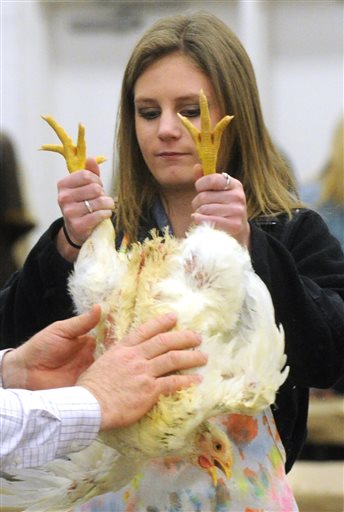SCOTT STAFFORD, The Berkshire Eagle
LANESBOROUGH (AP) — Kara Zaks has a way with animals, having worked as a veterinarian technician and in wildlife rehab.
“It’s my love and my passion,” she said. “I’ve been into animals all my life.”
She has a particular fondness for fowl— she has anywhere from 60 to more than 100 chickens and ducks, along with four roosters, in the pen in her backyard, depending on the time of the year.
Her neighbor is not so fond of the noise and the smell.
“It’s been a nightmare,” said Clark Gable, whose property adjoins Zaks’ on Narragasett Avenue, which is in a residential neighborhood near Pontoosuc Lake.
The neighborhood dispute came to a head in late July, when police were called and inspectors summoned. But the inspectors were satisfied with the health conditions of the pen and there is no law in Lanesborough— at least not yet —regarding the keeping of poultry.
Lanesborough is not alone. Many cities and towns across the country have been forced to evaluate their regulations, or lack thereof, regarding the raising of poultry in urban and suburban residential neighborhoods, especially in the past few years as the movement for self-sustainability and locally grown foods has gained more traction.
Zaks enjoys knowing that the poultry and eggs she feeds her family were raised humanely and fed well. And she likes to sell some of her home-raised poultry to like-minded friends for either food or as pets.
“I wanted to raise and eat my own food,” she said. “Especially after I found out how these poor creatures are raised in factory farms.”
On a daily basis she lets them roam the yard for little while, snacking on insects and seeds. Their clucking and quacking can be somewhat soothing to some. The droppings she uses as fertilizer in her vegetable garden.
She is also helping to preserve some rare breeds of duck. And she donates eggs to a local school where they are tended to by students until after they hatch.
“I raise them because they are my sanity,” she said. “It is relaxing. I also am trying to conserve rare lineage breeds.”
Gable likes to relax with his family on pleasant summer evenings in a gazebo, which is near the property line. Zaks’ flock is about 40 feet from the same property line and further back from the road, but still fairly close to the gazebo.
While Zaks said she cleans the pen daily, that’s of little solace to her neighbor.
“We’ve made attempts to work together but gotten nowhere. The unfortunate part of it is the lack of consideration for the neighbors,” Gable said. “The roosters crowing, the smell, and the appearance is absolutely horrible. When the wind changes, the smell is ungodly at the end of the day.”
In an attempt to resolve the dispute, the three members of the Selectboard proposed a bylaw in December that would ratchet down the number of animals including chickens and ducks, to about six on any property smaller than an acre. It also banned roosters on such parcels.
Zaks proposed a few changes that would have required some study, so the proposal was tabled.
According to Town Manager Paul Sieloff, the Selectboard will likely come forward with another proposal soon, and present it to the next town meeting.
“(Zaks’ poultry raising) seems on its face to be too big of an operation on too small a piece of land,” he said. “So the question becomes what is appropriate for an area like this?”
With no set standard on that type of regulation, there is a wide variety of bylaws and zoning regulations employed by cities and towns regarding raising fowl. Recent similar dust-ups have occurred in Omaha, Brooklyn, Daytona Beach, Dallas, as well as Ogden, Utah and Savannah, Georgia.
“It’s popping up all over the country,” noted Erik Knutzen. He is the co-author, with his wife, Kelly Coyne, of “The Urban Homestead,” and writes for magazines including “Make” and “Urban Farm.” He has converted his Los Angeles yard into a working urban agricultural operation.
“And in terms of municipal code,” he said, “it’s not consistent at all. It’s kind of all over the place.”
In Boston, for example, all residential zones forbid “auxiliary keeping of animals,” which includes poultry and other livestock except in accordance with a permit from the Division of Health Inspections.
In Raleigh, North Carolina, there is no limit on the number of chickens kept. In San Francisco, a resident can keep any combination of four small animals on the property, including dogs, cats, and chickens, without a permit.
In Albuquerque, zoning allows the raising of an unlimited number of poultry if penned at least 20 feet from neighboring dwellings.
“Chickens for some reason cause people to freak out for no real reason,” Knutzen said. “But in a suburban area or a city, I can understand wanting to regulate that somewhat. And some reasonable compromises can be constructive when these types of conflicts come up— such as fewer chickens, or more distance between the chickens and the property lines.”
“Twelve to 15 birds would be fine,” Gable said. “And having fresh eggs and poultry is great, but when you take it to the level that (Zaks) has, it’s just obnoxious. That’s a lot of birds.”
Zaks says she is willing to work with the town and reduce the size of her flock.
“But I’d like to keep enough to still run my business, and for others in town to still have their poultry and to raise their own food,” she said.
Robert Ericson, a member of the Lanesborough Selectboard, said that there are other residents of town that raise chickens, so whatever regulation they decide on will have to apply to everyone in town.
“But it would be nice to have something in place soon because this issue is going to come up again and again,” he said.


